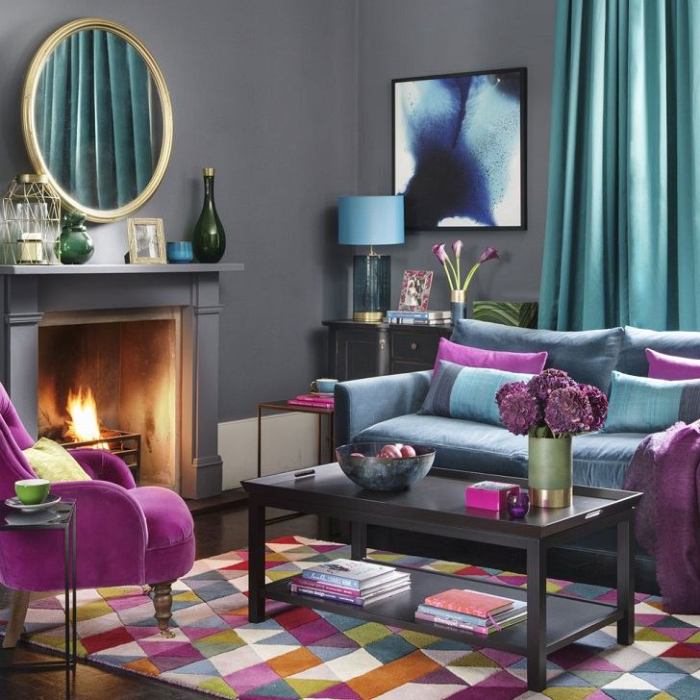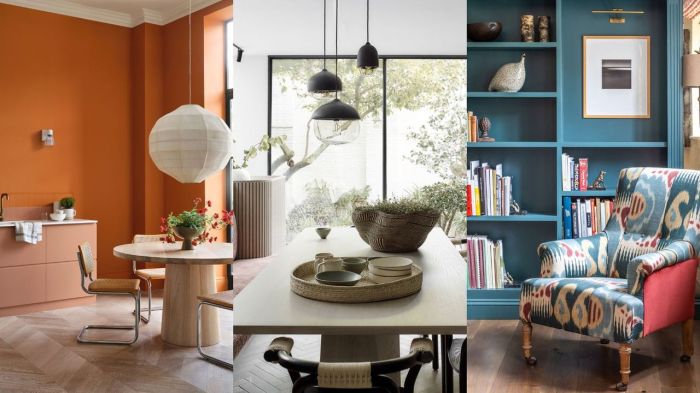Crafting the Perfect Room Colour Design: A Comprehensive Guide
Step into the world of room colour design, where hues and tones play a crucial role in shaping the ambiance and mood of a space. From the impact of different colors on our perception to the art of creating a cohesive color palette, this guide delves deep into the fascinating realm of color psychology and design.
Explore the factors, schemes, techniques, and personalization tips that will help you transform any room into a vibrant and visually appealing haven.
Importance of Room Color Design
Room color design plays a crucial role in setting the mood and ambiance of a space. The colors we choose can greatly impact our emotions, productivity, and overall well-being.
Impact of Room Color on Mood and Ambiance
Colors have the ability to evoke different emotions and affect our perception of a room. For example, warm colors like red, orange, and yellow are known to create a cozy and inviting atmosphere, perfect for living rooms or dining areas.
On the other hand, cool colors such as blue, green, and purple can promote a sense of calmness and relaxation, ideal for bedrooms or home offices.
Role of Color Psychology in Room Design
Color psychology is the study of how colors can influence human behavior and emotions. Interior designers often use this concept to create spaces that cater to specific needs or goals. For instance, using shades of green in a workspace can enhance concentration and productivity, while incorporating earth tones in a bedroom can promote a sense of tranquility and restfulness.
Factors to Consider
When choosing room colors, there are several factors to consider to ensure the desired atmosphere and aesthetic are achieved. Factors such as natural light, room size, and personal preferences play a significant role in color selection.
Natural Light Influence
Natural light can greatly impact how colors appear in a room. Rooms with ample natural light tend to make colors appear brighter and more vibrant, while rooms with limited natural light may cause colors to look dull and darker. It is essential to consider the direction of windows and the amount of light entering the room throughout the day when selecting colors.
Cooler tones like blues and greens work well in rooms with abundant natural light, while warmer tones like yellows and oranges can help brighten up spaces with less light.
Relationship with Room Size
The size of a room can also influence the choice of colors. Darker colors can make a room feel cozy and intimate, which is ideal for larger rooms that may otherwise feel too spacious. On the other hand, lighter colors can create a sense of openness and airiness, making smaller rooms appear more significant.
It is essential to strike a balance between the size of the room and the chosen color to achieve the desired effect. Additionally, using light colors on walls and darker tones for accents can help create depth and dimension in any size room.
Popular Room Color Schemes

When it comes to choosing color schemes for different rooms in your home, it's essential to consider the overall mood and ambiance you want to create. From calming neutrals to bold and vibrant hues, the right color scheme can truly transform a space.
Let's explore some popular room color schemes and how you can create a cohesive look for your home.
Bedroom
In the bedroom, it's important to create a relaxing and cozy atmosphere. Soft, soothing colors like light blue, lavender, or pale pink are popular choices for the walls. These colors can help promote restful sleep and relaxation. To add visual interest, consider incorporating pops of color through accent pillows, throws, or artwork.
A monochromatic color scheme using different shades of the same color can also create a cohesive look.
Living Room
For the living room, you have more flexibility to play with bold colors and patterns. Neutral colors like beige, gray, or white can serve as a great base, allowing you to add in pops of color with accent furniture or decor pieces.
Earthy tones like olive green, terracotta, or mustard yellow are trending for living rooms and can bring warmth and depth to the space. Consider mixing textures and patterns to create a visually dynamic room.
Kitchen
In the kitchen, it's all about creating a space that is both functional and inviting. White kitchens are a classic choice, but you can also experiment with shades of blue, green, or even black for a modern look. Light and bright colors can make a small kitchen feel more open and airy, while darker hues can add drama and sophistication.
Consider incorporating natural elements like wood or plants to balance out the color scheme.
Creating a Cohesive Color Palette
To create a cohesive color palette for a room, start by choosing a main color as your base and then select complementary colors to enhance the overall look. Use the 60-30-10 rule, where 60% of the room is your dominant color, 30% is a secondary color, and 10% is an accent color.
This balance ensures a harmonious and visually appealing space.
Contrasting and Complementary Color Combinations
Contrasting colors, such as blue and orange or purple and yellow, can create a vibrant and dynamic look in a room. On the other hand, complementary colors, like blue and green or red and orange, can create a harmonious and balanced feel.
Experiment with different color combinations to see what works best for your space and personal style.
Application Techniques
When it comes to applying room color design, there are various techniques that can help you achieve the desired look and feel for your space. From testing paint colors to utilizing accent walls, each method plays a crucial role in enhancing the overall aesthetic of a room.
Testing Paint Colors
Before committing to a specific paint color for your room, it is essential to test out different shades to see how they look in different lighting conditions. Here are some tips on how to effectively test paint colors:
- Use paint samples: Purchase small sample cans of the colors you are considering and paint a small section of the wall to see how it looks throughout the day.
- Observe in natural light: Colors can appear differently in natural light compared to artificial light, so make sure to evaluate the samples in both lighting conditions.
- Consider the undertones: Pay attention to the undertones of the colors and how they complement or clash with other elements in the room.
Accent Walls
Accent walls are a great way to add depth and character to a space without overwhelming the entire room with a bold color. Here's how you can effectively use accent walls in your room design:
- Choose the right wall: Select a wall that serves as a focal point in the room, such as the one behind the bed or sofa.
- Opt for a complementary color: Pick a color that complements the existing color scheme of the room to create a cohesive look.
- Experiment with patterns: Consider using wallpaper, stencils, or textured paint to create visual interest on the accent wall.
Color Temperature
The temperature of a color (warm vs. cool) can significantly impact the overall feel of a room. Understanding how color temperature works can help you create the desired ambiance in your space:
- Warm colors (reds, oranges, yellows) create a cozy and inviting atmosphere, perfect for spaces where you want to promote relaxation.
- Cool colors (blues, greens, purples) evoke a sense of calm and serenity, ideal for areas where you want to encourage focus and productivity.
- Balance warm and cool tones: Mixing warm and cool colors can create a harmonious balance in a room, allowing you to play with different moods and aesthetics.
Personalizing Room Colors

When it comes to personalizing room colors, it's essential to choose shades that resonate with your individual style and preferences. The colors you select can have a significant impact on the overall ambiance of the room, reflecting your personality and creating a space that feels uniquely yours.
Incorporating Textures and Patterns
Adding textures and patterns to your chosen colors can elevate the visual interest of a room. For example, you can combine a solid colored wall with textured throw pillows on a couch or patterned curtains to create depth and dimension.
Mixing and matching different textures and patterns can add a dynamic element to the room while still maintaining a cohesive color scheme.
Color Coordination with Furniture and Decor
Color coordination with furniture and decor is crucial in achieving a harmonious look in a room. Consider the existing colors of your furniture pieces and accessories when selecting wall colors. You can choose complementary or analogous colors to create a cohesive color palette that ties everything together.
Additionally, using accent colors from your decor in small details like throw blankets or artwork can help tie the room's color scheme together seamlessly.
Final Conclusion
As we conclude this exploration of room colour design, remember that the right color choices can truly transform a space. Whether you're aiming for a calming retreat or a bold statement room, let your creativity and knowledge of color design guide you towards creating the perfect environment that reflects your style and personality.
FAQ Corner
How does room color affect mood and ambiance?
Room color can evoke different emotions and set the tone for a space. Warm colors like red and orange can create a cozy atmosphere, while cool colors like blue and green promote a sense of calm.
What factors should be considered when choosing room colors?
Factors such as natural light, room size, and personal preferences should be taken into account when selecting room colors to ensure the desired outcome.
How can I test paint colors before committing to a room?
Paint color samples can be applied to small sections of the wall to see how they look in different lighting conditions before making a final decision.
Why is color coordination with furniture and decor important?
Color coordination helps create a cohesive look in a room, tying together different elements to achieve a harmonious and visually pleasing space.




